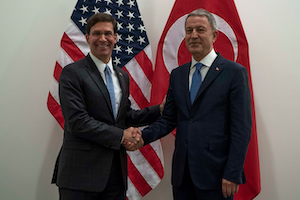
BACKGROUND: Turkey’s minimal objective is to prevent the establishment of a contiguous Kurdish-dominated entity along its southern border. In essence, Turkey seeks the status quo ante in northern Syria prior to the pivotal 2014 battle of Kobani that turned the tide in the war against ISIS but disrupted U.S.-Turkey relations. When ISIS attacked Kobani, the U.S. formed a partnership with the Kurdish Peoples’ Protection Units (YPG) as a means to defeat ISIS in Syria, despite the group’s affiliation with Turkey’s outlawed Kurdistan Workers’ Party (PKK), designated as a terrorist organization by the U.S. In Ankara’s eyes, U.S. military assistance to the YPG breached America’s most fundamental obligations as a NATO ally.
Supported by U.S. air cover and weapons, the YPG defeated ISIS in Kobani and its hinterland in the spring of 2015. The emboldened YPG, buoyed by its superpower support, then went on the offensive and captured the strategic town of Tal Abyad from ISIS on June 15, 2015. From Tal Abyad, further YPG campaigns forged a contiguous corridor along the length of the Turkish border east of the Euphrates.
Facing the prospect of the YPG extending this corridor westwards across the Euphrates to the Kurdish enclave of Afrin, Turkish President Recep Tayyip Erdoğan put the international community on notice: "I am addressing the whole world," Erdoğan declared on June 26, 2015, "We will never allow a state to be formed in northern Syria, south of our border."
To meet its minimum goal, Turkey ideally wants a stationary presence in several locations extending 20 miles southward in order to cut northern Syria’s M-4 highway, the region’s commercial artery running parallel to the Turkish border. By controlling pieces of the highway, Turkey could in effect recreate separate Kurdish cantons without having to invade major population centers.
Turkey’s intermediate goal is to reverse the consolidation of Kurdish control over the area east of Kobani facilitated by the YPG’s capture of Arab-majority Tal Abyad. Beyond the YPG’s military withdrawal from Kobani and Tal Abyad as per the original American safe zone proposal, Ankara seeks the resettlement of Turkey’s Syrian Arab refugees in these towns and their surrounding areas. For this, Turkey would need to conduct operations similar to its 2018 Operation Olive Branch invasion of Afrin that ultimately displaced 300,000 Kurds, with Turkey allegedly overseeing the resettlement of displaced Arabs from other parts of Syria on vacated Kurdish property.
Turkey’s maximal goal is to preclude any possibility of Kurdish autonomy in northern Syria by eliminating Kurdish majority areas altogether. Turkey hosts 3.6 million registered Syrian refugees who have become extremely unpopular among the Turkish population. With polls showing majorities reaching over 80 percent in favor of sending all the refugees back, Turkey’s Syrian refugees are now a political liability for Erdoğan and his ruling Justice and Development Party (AKP).
By repeating the Afrin experience on a wider scale, the AKP-led government could curry favor with its voter base while also shifting the demographic balance against the Kurds. Reports have surfaced of Turkish plans to relocate 700,000 Syrian refugees to northern Syria. Even now, the forcible return of Syrian refugees has been increasing on an unprecedented scale.
IMPLICATIONS: On August 1, in the run-up to the negotiations, Erdoğan convened Turkey’s Supreme Military Council for the first time since his June 24, 2018 election as president under Turkey’s new presidential system. The Supreme Military Council’s promotion and retirement of generals saw a re-shuffling of higher brass by Turkey’s president and defense minister to create a senior military staff more amenable to cooperation with the U.S.
After three days of eleventh-hour talks between the U.S and Turkish militaries in Ankara, the U.S. State Department announced that the two NATO allies had concluded an agreement to rapidly implement "initial measures to address Turkey’s security concerns," and to create a joint operations center within Turkey to manage the establishment of a safe zone in northern Syria. The statement explained that "the safe zone shall become a peace corridor," employing the Turkish euphemism, and further nodded toward Turkey’s goals by adding "and every effort shall be made so that displaced Syrians can return to their country."
The ambiguous language that stemmed a Turkish invasion is a far cry from the 20 to 25-mile deep safe zone Turkey sought to administer spanning 236 miles of its border with Syria in order to clear the region of the YPG’s military forces, comprising the bulk of the multi-ethnic Syrian Democratic Forces (SDF) that defend the autonomous regions of northern Syria.
The day before the safe zone agreement announcement, U.S. Defense Secretary Mark Esper unequivocally declared that any unilateral action against Syrian Kurdish forces would be "unacceptable" to the United States. With Ankara appearing to accede to the American pushback, U.S. military officials in Turkey have begun working with their counterparts to establish an operations center for a jointly patrolled safe zone.
Just like appearances, ambiguous diplomatic language can be deceiving. The agreement’s so-called peace corridor provides for Turkey’s minimal goals without closing down Ankara’s options for attempting to achieve its intermediary and maximal goals. With somewhere between 1,000 to 2,000 U.S. personnel on the ground in northern Syria, the U.S. will not be able to deter Turkey’s larger ambitions without additional American troop deployments.
The U.S. understanding of the peace corridor envisions a limited Turkish military patrol presence in northern Syria chaperoned by U.S. forces to satisfy Turkey’s immediate security concerns while preventing armed clashes between the Turkish military and YPG forces. The U.S. vision also mostly accommodates the SDF’s position that accepts limited Turkish patrols but refuses to permit any "stationary Turkish presence."
The implementation of the safe zone will test American adroitness in accommodating Turkey’s objectives as broadly as possible while preserving the SDF’s administration of the region. A key task of the joint operations center is to determine the locations of U.S. and Turkish observation posts, including the routes by which Turkish forces can enter northern Syria east of the Euphrates.
The original U.S. proposal was to create a 5-7 mile deep zone along the 86-mile stretch from Qamishli to Kobani from which YPG forces would withdraw. The first phase of implementation will probably entail the establishment of observation posts in sparsely inhabited rural areas in this strip of territory to avoid Turkish contact with major Kurdish population centers. The locations of the posts could guarantee control over the entry and exit points of major urban towns of the corridor such as Kobani, Tal Abyad, and Qamishli. In this manner, Turkey will have achieved its minimal goals without an invasion that risked Turkish troops firing on American forces.
To satisfy Turkey’s need to repatriate Syrian refugees, the safe zone could be doubled to a 14-mile depth in certain areas such as the already predominantly Arab segment between Tal Abyad and Ras al-Ayn. This expanded area could accommodate the refugees while not changing the ethnic balance in any of the predominantly Kurdish areas. By relocating large numbers of Syrian refugees, Erdoğan’s AKP may score just enough political points to offset the strong misgivings among its voter base about Turkish cooperation with the U.S.
As for the strip 20-25 miles deep, Turkey could employ unarmed UAVs to satisfy its need for a Turkish monitoring presence to ensure removal of weapons that could threaten Turkish territory. As a confidence-building measure, the U.S. recently began permitting Turkish surveillance drones to operate in northeastern Syria.
CONCLUSIONS: Turkey’s Minister of Defense Hulusi Akar, who oversaw the August 5-7 negotiations, and perhaps President Erdoğan himself, may look upon the joint operations as a reset opportunity for the highly troubled U.S.-Turkey strategic relationship. Almost certainly, it will encourage U.S. President Donald Trump to continue to delay the activation of congressionally mandated economic sanctions against Turkey for its purchase of the Russian S-400 air defense system.
A pathway exists to create a sustainable arrangement that is tantamount to a de facto ceasefire between Turkey and the SDF. For deeper Turkish buy-in, the United States will have to accommodate enough of Turkey’s objectives to blunt Turkish domestic criticism and to render the cost of a Turkish invasion to achieve Turkey’s maximal objectives not worth the effort.
Doing so will enable Turkey-U.S. relations to move past Kobani and out of the quagmire in which the NATO allies have been stuck since the U.S.-YPG campaign to defeat ISIS.
AUTHOR’S BIO:
Dr. Micha’el Tanchum is a senior fellow at the Austrian Institute for European and Security Studies (AIES), a fellow at the Truman Research Institute for the Advancement of Peace, the Hebrew University, Israel, and non-resident fellow at the Centre for Strategic Studies at Başkent University in Ankara, Turkey (Başkent-SAM). @michaeltanchum
Image Source: Public Domain via U.S. Department of Defense via Wikimedia accessed on 8.29.19



